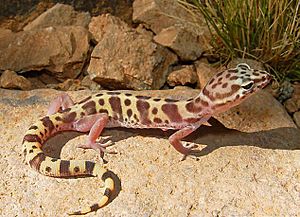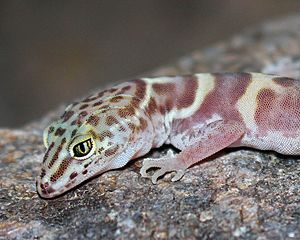Western banded gecko facts for kids
Quick facts for kids Western banded gecko |
|
|---|---|
 |
|
| Conservation status | |
| Scientific classification | |
| Genus: |
Coleonyx
|
| Species: |
variegatus
|
| Synonyms | |
The western banded gecko (Coleonyx variegatus) is a type of gecko that lives in the southwestern United States and northern Mexico. You can find them in places like southern California, Arizona, Utah, and Nevada. There are five different kinds, or subspecies, of this gecko.
Contents
About the Western Banded Gecko
The western banded gecko is a lizard that lives on the ground. It grows to be about 4 to 6 inches (10 to 15 cm) long, including its tail. When they hatch, baby geckos are only about 1 inch (2.5 cm) long!
Their bodies are sandy-colored with dark stripes that look like broken patches. Their skin feels very soft and silky because of their tiny scales. Unlike many other geckos, the western banded gecko has big eyes with eyelids that can move, just like ours!
Where They Live
Western banded geckos live in many different places. They can be found in desert areas with plants like creosote bush and sagebrush. They also live in forests with pinyon–juniper woodland trees. In some areas, they live among catclaw, cedar, and grama grass.
You can find them from places below sea level up to about 5,000 feet (1,520 meters) high.
Behavior and Life Cycle
The western banded gecko is a very shy animal. It is also nocturnal, which means it is active at night. At night, it hunts for small insects and spiders to eat. These geckos are special because they help control scorpion populations by eating baby scorpions!
If a western banded gecko feels caught or scared, it might make a squeaking sound. It can also drop its tail to escape from a predator. This is a defense trick! Another cool defense is curling its tail over its body. This makes it look like a scorpion, which might scare away animals that want to eat it.
Reproduction
Female geckos lay eggs in the spring and summer. They usually lay one or two soft-shelled eggs at a time, up to three times a year. The eggs hatch after about six weeks.
You might see these geckos near porch lights on warm nights. They go there to find easy meals like insects. But if it gets too hot or too cold, they will quickly hide away.
Who Eats Them?
Many animals hunt western banded geckos. Some of their predators include different types of snakes, such as leaf-nosed snakes, western patch-nosed snakes, night snakes, and various rattlesnake species like sidewinders and western diamondback rattlesnakes. Coachwhips and zebra-tailed lizards also eat them.
Other animals that might eat these geckos are tarantulas, large centipedes, solpugids (also known as sun spiders), coyotes, and kit foxes.
Types of Western Banded Geckos
There are five different subspecies, or types, of the western banded gecko. Each one has a slightly different name:
- Coleonyx variegatus abbotti (San Diego banded gecko)
- Coleonyx variegatus bogerti (Tucson banded gecko)
- Coleonyx variegatus sonoriensis (Sonoran banded gecko)
- Coleonyx variegatus utahensis (Utah banded gecko)
- Coleonyx variegatus variegatus (desert banded gecko)
Why the Names?
Some of these subspecies are named after people who studied animals. For example, abbotti is named after an American bird expert named Clinton Gilbert Abbott. The name bogerti honors an American expert on reptiles and amphibians named Charles Mitchill Bogert.



